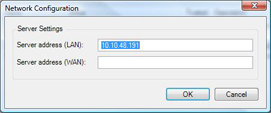Managing registered services
Occasionally, you have servers and/or services which should be able to communicate with the system even if they are not directly part of the system. Some services, but not all, can register themselves automatically in the system. Services that can automatically be registered are:
- Event Server service
- Log Server service
Automatically registered services are displayed in the list of registered services.
You can manually specify servers/services as registered services in the Management Client.
Add and edit registered services
- In the Add/Remove Registered Services window, click Add or Edit, depending on your needs.
- In the Add Registered Service or Edit Registered Service window (depending on your earlier selection), specify or edit settings.
- Click OK.
Manage network configuration
With the network configuration settings, you can specify the management server's server LAN and WAN addresses so the management server and the trusted servers can communicate.
- In the Add/Remove Registered Services window, click Network.
- Specify the LAN and/or WAN IP address of the management server.
If all involved servers (both the management server and the trusted servers) are on your local network, you can simply specify the LAN address. If one or more involved servers access the system through an internet connection, you must also specify the WAN address.

- Click OK.
Registered services properties
In the Add Registered Service or Edit Registered Service window, specify the following:
|
Component |
Requirement |
|---|---|
| Type |
Prefilled field. |
| Name |
Name of the registered service. The name is only used for display purposes in the Management Client. |
| URLs |
Click Add to add the IP address or hostname of the registered service. If specifying a hostname as part of a URL, the host must exist and be available on the network. URLs must begin with http:// or https:// and must not contain any of the following characters: < > & ' " * ? | [ ] ". Example of a typical URL format: http://ipaddress:port/directory (where port and directory are optional). You can add more than one URL if required. |
| Trusted |
Select if the registered service should be trusted immediately (this is often the case, but the option gives you the flexibility to add the registered service and then mark it as trusted by editing the registered service later). Changing the trusted state also changes the state of other registered services sharing one or more of the URLs defined for the relevant registered service. |
| Description |
Description of the registered service. The description is only used for display purposes in the Management Client. |
| Advanced |
When a service is advanced, it has specific URI schemes (for example, HTTP, HTTPS, TCP, or UDP) that need to be set up for each host address you define. A host address therefore has multiple endpoints, each with its own scheme, host address and IP port for that scheme. |
Was this article helpful?
Thanks for your feedback!

